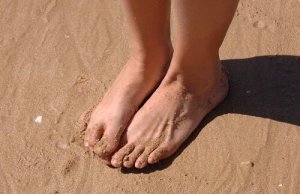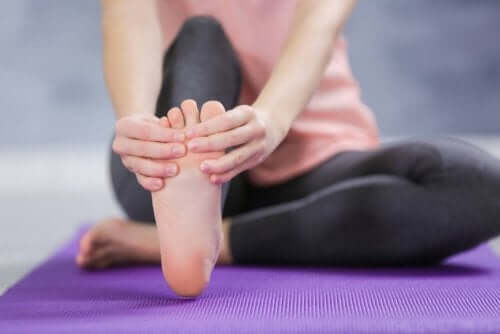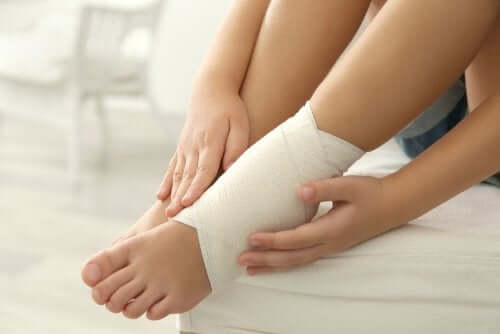Five Treatments for Swollen Ankles and Feet

Before you select a treatment for your swollen ankles and feet, it’s important to first determine the cause.
Does it have to do with the ligaments? Are you unable to move properly? If so, you must consult your doctor. However, if it’s just a slight injury or due to fluid retention, then try one of these remedies at home.
Swollen ankles and feet are common in older adults and pregnant women. However, they’re also common in athletes and people whose jobs involve physical effort. While it may result from poor circulation, trauma, and infections, swelling it’s almost always mild and can improve if you take some basic measures.
Are you ready for notes?
Treatments for Swollen Ankles and Feet
First, you must determine how severe your symptoms are before you try one of these tips to relieve your swollen ankles and feet. If it’s a specific type of swelling – the kind that happens after you’ve maintained the same posture for a while – then some simple exercises and basic care will suffice.
However, if your symptoms are persistent or you’re in pain and present bruising and walking difficulties, among others, then you must consult a doctor so they can prescribe appropriate treatment. They should be able to determine the type of injury you have with a physical exam and x-rays.
That said, here are some home remedies to take care of poor circulation and swelling at home.
1. Elevate your legs

The best exercise to relieve your swollen ankles and feet is to elevate your legs above your heart. This simple move improves circulation from the lower extremities to the heart, and in turn, reduces swelling.
It’s a great way to get quick relief if you’re numb or in pain.
What to do
- Lie on a comfortable surface, such as a bed or a yoga mat, and raise your legs in the direction of the ceiling.
- Keep them elevated for 10 to 15 minutes and then bring them down.
Discover: Swollen Hands – Causes and Remedies
2. Do some moderate exercise
Moderate physical exercise has therapeutic effects on lesions that lead to ankle swelling. In fact, it’s one of the best habits you can have, as it’ll reactivate your blood circulation. It’ll also prevent fluid retention.
The World Health Organization (WHO) advises that you do at least a couple of hours of moderate activity per week.
What to do
- Consult a doctor or physiotherapist about the exercises that’ll best help your specific case if you have an ankle injury.
- Avoid high-intensity routines until your injury heals.
- Opt for a moderate activity such as walking and swimming. You can also stretch using an elastic band.
3. Resting will help relieve swollen ankles and feet from injuries

While moderate exercise helps relieve swollen ankles, it’s also healthy to rest for a few days. Rest decreases the pressure the weight of your body puts on your ankles. Also, it contributes to muscle relaxation and promotes the recovery of affected tissues.
What to Do
- If you recently suffered an injury or sprained ankle, rest for 2 or 3 days.
- If you feel pain when resting on your foot, use crutches.
Read also: How to Tell if You’re Retaining Water
4. Apply ice
The application of ice packs can be very useful when treating swollen ankles. Cold temperature has a therapeutic effect because it reduces the levels of inflammation. Its application through a massage will accelerate pain relief and also decrease bruises and muscle spasms.
What to do
- Insert several ice cubes in a bag, or wrap them in a clean rag.
- Then, gently massage your ankles with it.
- Keep it up until you feel numb. Then, rest for two to four hours and repeat afterward.
- Do this treatment three or four days until your swelling is under control.
5. Use a bandage for an injured ankle

Bandaging the affected ankle is a good complement to other treatments to reduce swelling and bruising. Before doing so, you can massage the affected area with anti-inflammatory ointments or oils. Keep the bandage for two or more days, depending on the severity of the swelling.
What to do
- To begin, cut a horseshoe-shaped pad from a piece of felt. You can also purchase a pre-make wrap at many stores and pharmacies.
- Next, put it around the outside of the swollen ankle.
- Then, wrap an elastic bandage making sure it isn’t too tight. Make sure the bandage doesn’t cut your blood flow because it’ll worsen the swelling.
Finally, make an effort to improve your diet and avoid excessive salt intake. The latter will slow down any treatment because it increases fluid retention. Likewise, drink plenty of water and avoid alcohol and tobacco as much as you can.
All cited sources were thoroughly reviewed by our team to ensure their quality, reliability, currency, and validity. The bibliography of this article was considered reliable and of academic or scientific accuracy.
- Singh, D. P., Lonbani, Z. B., Woodruff, M. A., Parker, T. J., Steck, R., & Peake, J. M. (2017). Effects of topical icing on inflammation, angiogenesis, revascularization, and myofiber regeneration in skeletal muscle following contusion injury. Frontiers in Physiology. https://doi.org/10.3389/fphys.2017.00093
- Doherty, C., Bleakley, C., Delahunt, E., & Holden, S. (2017). Treatment and prevention of acute and recurrent ankle sprain: An overview of systematic reviews with meta-analysis. British Journal of Sports Medicine. https://doi.org/10.1136/bjsports-2016-096178
- Ha, S.-Y., Han, J.-H., & Sung, Y.-H. (2018). Effects of ankle strengthening exercise program on an unstable supporting surface on proprioception and balance in adults with functional ankle instability. Journal of Exercise Rehabilitation. https://doi.org/10.12965/jer.1836082.041
- Block, J. (2010). Cold and compression in the management of musculoskeletal injuries and orthopedic operative procedures: a narrative review. Open Access Journal of Sports Medicine. https://doi.org/10.2147/oajsm.s11102
- Van Den Bekerom, M. P. J., Struijs, P. A. A., Blankevoort, L., Welling, L., Van Welling, C. N., & Kerkhoffs, G. M. M. J. (2012). What is the evidence for rest, ice, compression, and elevation therapy in the treatment of ankle sprains in adults? Journal of Athletic Training. https://doi.org/10.4085/1062-6050-47.4.14
- Hansrani, V., Khanbhai, M., Bhandari, S., Pillai, A., & McCollum, C. N. (2015). The role of compression in the management of soft tissue ankle injuries: a systematic review. European Journal of Orthopaedic Surgery and Traumatology. https://doi.org/10.1007/s00590-015-1607-4
This text is provided for informational purposes only and does not replace consultation with a professional. If in doubt, consult your specialist.








